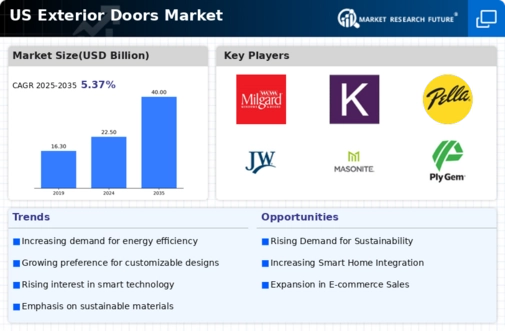Emergence of Aesthetic Trends
Aesthetic considerations are increasingly shaping consumer preferences in the exterior doors market. Homeowners are gravitating towards doors that not only serve functional purposes but also enhance the overall visual appeal of their properties. Recent market analysis suggests that decorative and custom-designed doors are gaining traction, with a reported increase in sales of such products by approximately 25% in the last year. This trend reflects a broader movement towards personalization in home design. The exterior doors market is adapting to these aesthetic demands by offering a wider variety of styles, colors, and materials, thereby catering to diverse consumer tastes.
Growth in Home Renovation Projects
The exterior doors market is significantly influenced by the ongoing growth in home renovation projects across the United States. As homeowners invest in upgrading their properties, the demand for new and stylish exterior doors is on the rise. Data indicates that the home renovation market has expanded by approximately 15% over the past year, with a substantial portion allocated to exterior improvements. This trend is fueled by the desire to enhance curb appeal and increase property value. Consequently, the exterior doors market is poised to capitalize on this momentum, as consumers seek high-quality, aesthetically pleasing doors that complement their renovated spaces.
Rising Demand for Energy Efficiency
The exterior doors market is experiencing a notable increase in demand for energy-efficient products. Homeowners are increasingly prioritizing energy savings, which is reflected in the growing popularity of insulated doors. According to recent data, energy-efficient exterior doors can reduce heating and cooling costs by up to 20%. This trend is driven by rising energy prices and a heightened awareness of environmental impact. As a result, manufacturers are focusing on developing doors that meet or exceed energy efficiency standards, thereby enhancing their market appeal. The exterior doors market is likely to benefit from government incentives aimed at promoting energy-efficient home improvements, further driving sales and innovation in this sector.
Increased Focus on Security Features
Security remains a paramount concern for homeowners, driving innovation within the exterior doors market. The demand for doors equipped with advanced security features, such as smart locks and reinforced materials, is on the rise. Recent surveys indicate that over 60% of consumers consider security a critical factor when selecting exterior doors. This trend is prompting manufacturers to integrate cutting-edge technology and robust designs into their products. As a result, the exterior doors market is likely to see a surge in sales of high-security doors, appealing to safety-conscious consumers who prioritize protection for their homes.
Technological Advancements in Manufacturing
Technological advancements are playing a crucial role in shaping the exterior doors market. Innovations in manufacturing processes, such as automation and the use of sustainable materials, are enhancing production efficiency and product quality. Recent reports indicate that the adoption of advanced manufacturing technologies has led to a reduction in production costs by up to 10%. This shift not only benefits manufacturers but also allows for competitive pricing in the exterior doors market. As the industry embraces these technological changes, it is likely to see an increase in the availability of high-quality, durable doors that meet evolving consumer expectations.




















Leave a Comment